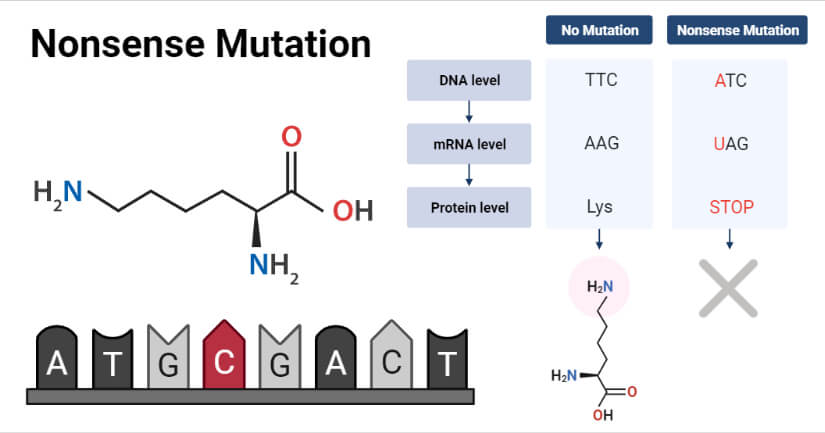Interesting Science Videos
Nonsense mutation definition
A nonsense mutation is a type of mutation where a premature stop codon is added to a sequence which hinders the further translation of the protein-coding gene.
- The nonsense mutation is classified as a loss-of-function change where the mutation impairs the production of a particular protein.
- Nonsense mutation, like most other mutations, can have a range of effects on the production and function of proteins.
- However, since shortened protein products are easily digested by proteasomes, a nonsense mutation can be considered equivalent to the full deletion of the gene.
- The actual functional effect of nonsense mutation depends on the location of the stop codon and its distance from the upstream sequence.
- A nonsense mutation can also be a silent mutation if the mutation occurs right before the last amino acid in a protein. In this case, the function of the protein remains unaffected.
- Some cases of beneficial nonsense mutation can also be observed where the change in amino acid sequence increases the fitness and reproductive success of the organism.
- The codons formed by the changes during mutation are termed nonsense codons as these do not code for any amino acid and instead are involved in the regulation of translation.

Causes of nonsense mutation
- Nonsense mutation takes place due to the introduction of a nucleotide into a sequence which results in the formation of a premature stop codon.
- The introduction or change of the existing codon into a stop codon can occur either by the insertion of a nucleotide sequence or the deletion of a nucleotide.
- The mutation can either be a spontaneous mutation caused during DNA replication or induced due to the introduction of mutagens.
- Spontaneous mutations occur as a result of some mistake during the processing of the DNA sequence.
- Induced mutations occur due to the introduction of some physical factors like radiation or chemical molecules.
- Different molecules might also be responsible for mutation, including reactive oxygen species that affect particular nucleotides within a sequence.
- The spontaneous mutation occurs on single-strand DNA molecules that remain separated during replication.
- The mutation during replication might also be induced due to digestion by nucleases.
Mechanism of nonsense mutation
- The mechanism of mutation depends on the cause of mutation, but the most common mechanism of mutation is tautomerism.
- The nucleotides exist in two tautomeric forms; keto form and enol form. The keto form is more common and forms hydrogen bonds with other nucleotides. The enol form is rare.
- During mutation, however, the keto form might convert into enol form as a result of either ionization or other molecules.
- The conversion of the keto form into enol forms changes the nature of bonding between the nucleotides, which, in turn, affects the sequence of amino acids produced.
- Besides, in some cases, different mutagens can be added to the sequence, which causes the insertion of different nucleotides. The insertion of a nucleotide changes the sequence of the codon.
- Similarly, some nucleotides can also be digested by enzymes during replication or other processes. The digestion causes the loss of such nucleotides and gives rise to a new set of codons.
- In the case of nonsense mutation, the stop codon UAG, UAA, or UGA are formed prematurely. There are multiple possibilities of these codons by the multiple changes in a single nucleotide.
Applications of nonsense mutation
The following are some of the applications of nonsense mutation;
- Nonsense mutation can be used as a means of therapy to prevent the production of cancerous that is triggered by the absence of stop codons.
- Nonsense mutation can bring about various changes that increase the fitness of different living organisms and their chances of survival in an ecosystem.
- It has been reported that nonsense mutations are the cause of about 5-15% of all disease-causing mutations.
- Nonsense mutations can be used in laboratories to study the stability and workings of different proteins.
Examples of nonsense mutation
- Beta thalassemias are a group of blood disorders that occur as a result of point nonsense mutation on the gene coding for the beta chains of hemoglobin.
- The result of the mutation can range from severe anemia to clinically asymptomatic cases depending on the position of the mutation.
- The point mutation, in this case, can either occur by the substitution of a single base or by the deletion of a nucleotide.
- The substitution occurs near the promoter regions preceding the beta-globin genes. In the case of deletion, certain nucleotides are deleted from the region near the upstream of the beta-globin gene.
- The alteration of the gene causes the formation of a premature stop codon which prevents the formation of the globin protein.
References
- Berkowitz, D et al. “Procedure for identifying nonsense mutations.” Journal of Bacteriology vol. 96,1 (1968): 215-20. doi:10.1128/JB.96.1.215-220.1968
- Jopling, Catherine L. “Stop that nonsense!.” eLife vol. 3 e04300. 9 Sep. 2014, doi:10.7554/eLife.04300
- Torella, Annalaura et al. “The position of nonsense mutations can predict the phenotype severity: A survey on the DMD gene.” PloS one vol. 15,8 e0237803. 19 Aug. 2020, doi:10.1371/journal.pone.0237803
